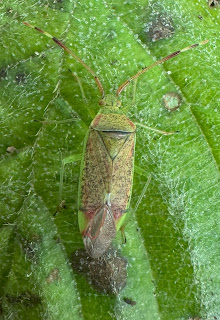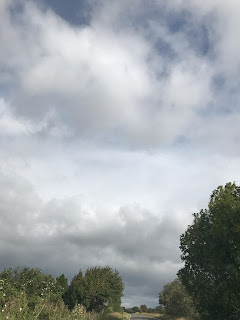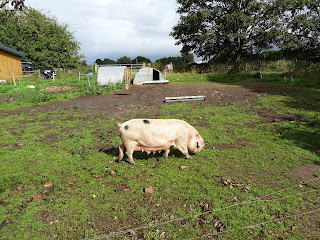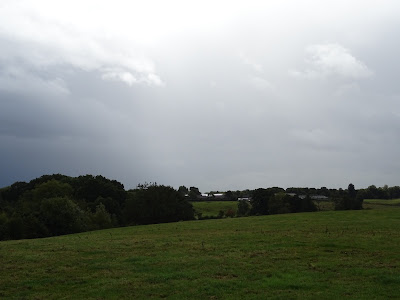Wednesday 18th September, Nesscliff Training Area
This outing was to the Ministry of Defence site close to Nesscliffe. For some reason the MOD have dropped the “e” and the site is signposted as Nesscliff Training Area.
Following a Dipterists' Forum meeting that visited the MOD area on Salisbury Plain our fly man was able to establish a contact with the MOD. He used this to gain access to the Nesscliff site. However, it took a great deal of effort accompanied by lots of frustration to get us in, but it came to fruition on this Wednesday as we met at the gates to the site.
The first thing we did on arrival is get back in the cars and leave.
We drove to another entrance where we made our way towards the area of the site we wanted to visit.
After driving along the track for a while we parked by a disused building.
But this was not our destination.
Arranging ourselves into as few cars as possible we proceeded to our final parking spot.
This series of manoeuvres was repeated in reverse at the end of our visit, apart from returning to the site entrance gates. We went straight home instead.
We started in in an area of grassland close to where we parked. Nearby was a Helicopter landing spot. Overhead, not too far away, was a helicopter. We assumed it was coming in to land, but it did not. It just flew around the site for what seemed like the rest of the morning.
When this area had been scouted out prior to our visit it was uncut grassland.
It was uncut no longer!
However, a small island of long grass with a few trees and bushes had been retained, and this was the target of our initial searches.
After a while we moved on, following a track that would take us to our second target site, a large area of wet grassland. The track was bordered by a decent hedgerow, some mature trees and a few grassland clearings.
The track then crossed a field in which some cattle were grazing. We moved fairly swiftly across this field to an area of woodland where we had our lunch.
Lunch over we explored the woodland before ambling on the large area of wet grassland, where we spent most of the afternoon.
The vegetation was quite tall and difficult to walk through but, fortunately, cattle had roamed the area before us which had created some tracks that we could follow more easily.
This grassland was surrounded on two sides by woodland and on the others by hedgerow.
After a good search of the grassland to see what we could find we concentrated on the woodland and hedgerows, before reassembling close to the track that had brought us to this part of the site.
A decision had to be made.
Return the shorter way, retracing our steps, or take a longer route.
Never ones for backing down from a challenge, we took the longer route, keeping an eye out for species of interest as we progressed.
Eventually we returned to the cars and undertook our reverse set of manoeuvres.
What a lot of words…
And no pictures to brighten up the text.
For this report I decided to tell the tale of the day and then present the pictures of some of the things we found.
Here they are.
But first, although the habitats were not particularly inspiring we did manage to find three species that had never been recorded in the county before.
A frit fly, Lasiochaeta pubescens. I do not have a photograph of the fly we found but a photograph of one can be seen by following this link: https://www.flickr.com/photos/sjthomasbotany4/53203169533/in/pool-chloropidaeuk
A Sepsid fly, Themira leachii.
 |
| Photograph: Nigel Jones |
And a wasp, Eupelmus vesicoloris.
 |
| Photograph: Nigel Jones |
One of the first observations was two species. A 7-spot ladybird with a cocoon of the parasitic wasp Dinocampus coccinellinae between its legs.
 |
| Photograph: Maria Justamond |
I am afraid this is an example of a rather gruesome relationship. An adult wasp seeks out a ladybird. It oviposits an egg into the ladybird. The egg hatches within the ladybird’s body and develops within the live insect. The final instar of the wasp emerges from the ladybird’s abdomen. It then spins a silken cocoon between the ladybird’s legs and pupates. The ladybird is trapped and usually dies of starvation as a result.
Back to the photographs!
A Ruby tiger moth larva.
 |
| Photograph: Nigel Cane-Honeysett |
A weevil, we believe to be a Sitona species but do not know which one.
 |
| Photograph: John Martin |
A fly with distinctive orange patches at the base of its wings, often seen basking on sunlit vegetation, Mesembrina meridiana.
 |
| Photograph: Nigel Cane-Honeysett |
A pair of Ivy ladybirds.
 |
| Photograph: Maria Justamond |
The nymph of our largest planthopper, Ledra aurita.
 |
| Photograph: Maria Justamond |
A leaf beetle, Galerucella lineola.
 |
| Photograph: Nigel Cane-Honeysett |
A Field grasshopper.
 |
| Photograph: David Williams |
Another beetle, this time a rove beetle, Micropeplus staphylinoides.
 |
| Photograph: Nigel Cane-Honeysett |
A small ladybird, Rhyzobius litura.
 |
| Photograph: David Williams |
A carrion beetle, Phosphuga atrata.
 |
| Photograph: Nigel Cane-Honeysett |
A longhorn beetle, Pogonocherus hispidus.
 |
| Photograph: David Williams |
A harvestman, Paroligolophus agrestis.
 |
| Photograph: Nigel Cane-Honeysett |
A very large moth larva, an Elephant hawk-moth.
 |
| Photograph: David Williams |
Another leaf beetle, Chrysolina banksii.
 |
| Photograph: Nigel Cane-Honeysett |
An Angle shades moth.
 |
| Photograph: Maria Justamond |
A mirid bug, usually found on alders, hawthorns and birches, Pantilius tunicatus.
 |
| Photograph: Nigel Cane-Honeysett |
A sawfly larva that has yet to be identified.
 |
| Photograph: John Martin |
A Common rough woodlouse.
 |
| Photograph: Nigel Cane-Honeysett |
A bee, a recent colonist of this region, which feeds at Ivy flowers, Colletes hederae.
 |
| Photograph: John Martin |
A ground bug that is associated with nettles, Heterogaster urticae.
 |
| Photograph: Nigel Cane-Honeysett |
A weevil with very long and fine rostrum, Curculio glandum.
A fairly common beetle, but it could be either Oulema melanopsis or Oulema duftschmidi. The two species are indistinguishable based on external features so they are combined for our purposes and called Oulema melanopsis agg.
Another harvestman, Opilio canestrini.
 |
| Photograph: John Martin |
A 22-spot ladybird
 |
| Photograph: Nigel Cane-Honeysett |
A Common darter.
 |
| Photograph: John Martin |
A fairly distinctive spider Diaea dorsata.
 |
| Photograph: Nigel Cane-Honeysett |
For some relief from all these invertebrates, a plant, Marsh cinquefoil, which likes wet, boggy places, fens and peaty meadows.
 |
| Photograph: John Martin |
A collection of ladybirds. In size order, a 14-spot, a 16-apot and Rhyzobius litura.
 |
| Photograph: Maria Justamond |
And finally, has anyone any idea what this is?
 |
| Photograph: Nigel Cane-Honeysett |
Fordhall Farm Postcript
I have a confession to make.
I was sent the following photographs before I prepared the report on this visit. Regrettably I forgot all about them and did not include them.
So, with apologies to the photographer, here they are.
Our favourite parasitic wasp, the tiny Callitula pyrrhogaster.
 |
| Photograph: Nigel Cane-Honeysett |
A pair of woodlice; the first is a Common striped woodlouse.
 |
| Photograph: Nigel Cane-Honeysett |
The second a Common shiny woodlouse.
 |
| Photograph: Nigel Cane-Honeysett |
A hoverfly, Rhingia campestris.
 |
| Photograph: Nigel Cane-Honeysett |
A staphylinid beetle, Metopsia clypeata.
 |
| Photograph: Nigel Cane-Honeysett |
A moth, Argyresthia goedartella.
 |
| Photograph: Nigel Cane-Honeysett |
A Garden spider.
 |
| Photograph: Nigel Cane-Honeysett |
An adult of the mirid bug mentioned in the report, Pantilius tunicatus.
 |
| Photograph: Nigel Cane-Honeysett |
A wasp, no idea what it is, but it is a wonderful metallic colour.
 |
| Photograph: Nigel Cane-Honeysett |
An ichneumon wasp which may be Ichneumon sarcitorius.
 |
| Photograph: Nigel Cane-Honeysett |
A female Rhinoceros beetle.
 |
| Photograph: Nigel Cane-Honeysett |
And, finally, a leaf beetle that is uncommon in the county of Shropshire, Plagiodera versicolora.
 |
| Photograph: Nigel Cane-Honeysett |
My thanks to the Ministry of Defence for granting us permission to do what we enjoy doing. My admiration and appreciation to the photographers for their excellent images and allowing me to use them in this report.













%20DW%202024-09-11%20(3).jpg)
%20DW%202024-09-11%20(1).jpg)

































